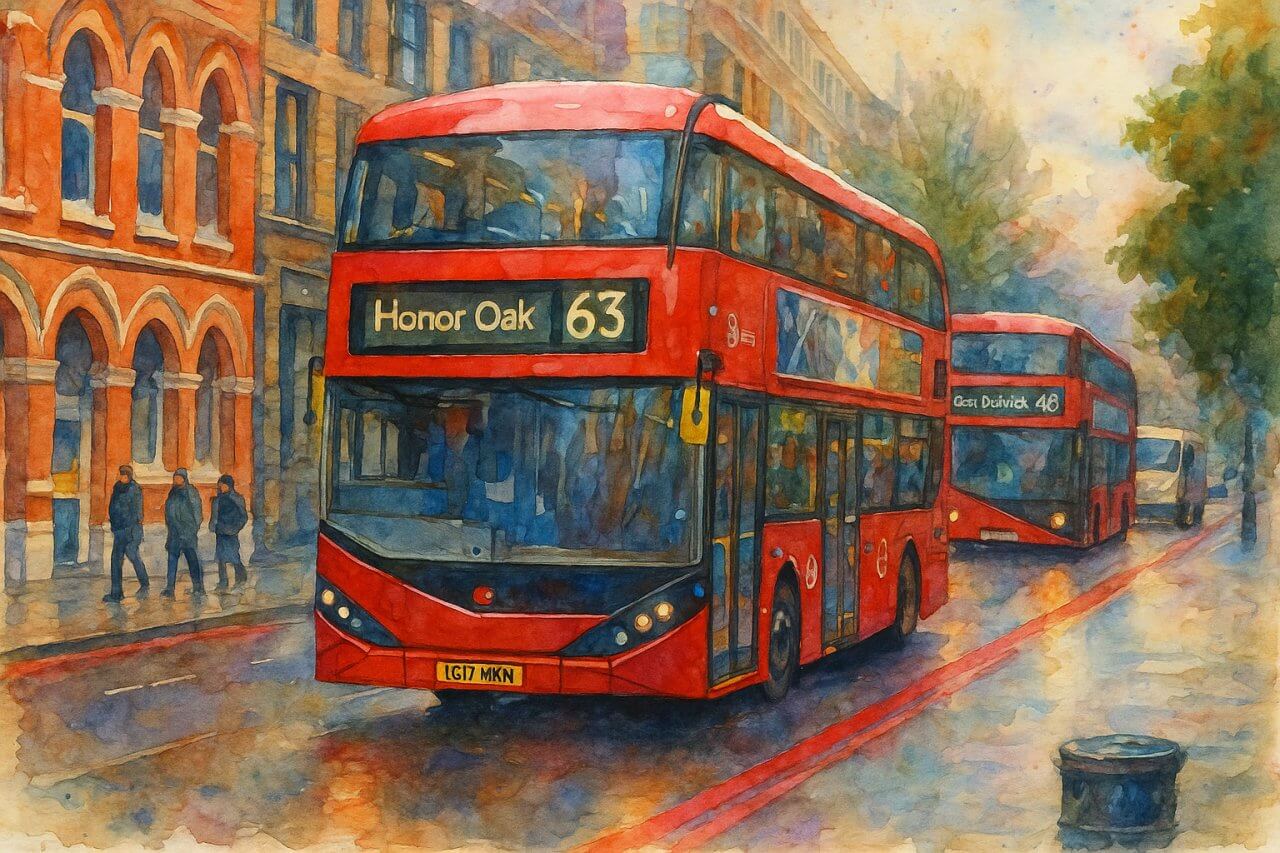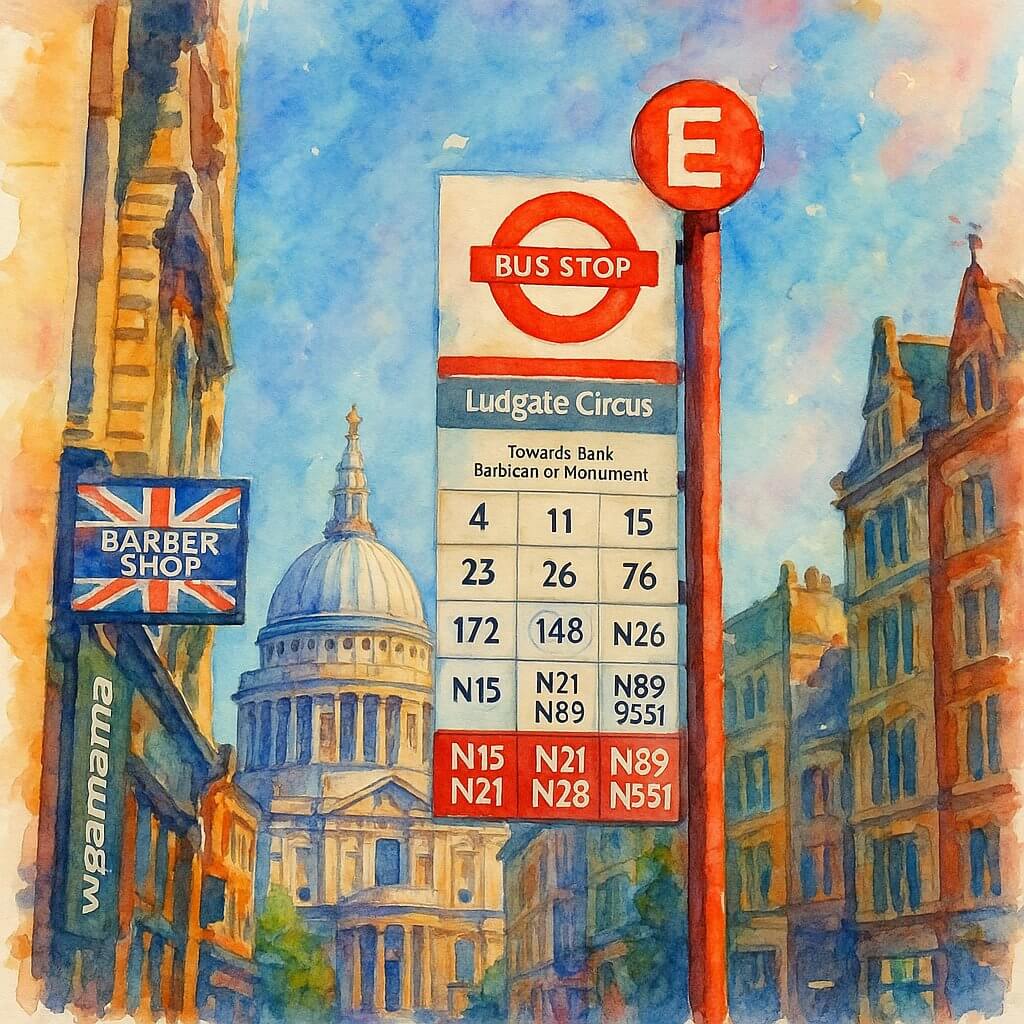
How to Take the Bus in London: A Complete Guide for Visitors
Introduction to London’s City Bus Services
London’s famous red buses are a convenient, scenic, and affordable way to explore the city. Whether you’re heading to a major attraction or just travelling a few stops, buses can take you almost anywhere in Greater London.The city’s bus services are not run by a single company. Instead, they are operated by private bus companies under contract to Transport for London (TfL), which is a government organisation responsible for managing London’s public transport network. This means that while different companies operate the buses, they all follow the same rules, pricing structure, and branding. You’ll recognise them easily by their distinctive red livery and roundel symbol.

Painting of London buses (View image in full size)
Where to Find Bus Routes and Timetables
You don’t need to be a local to figure out where the buses go. There are several ways to get bus route and timetable information:- Journey Planner on the TfL Website: A very user-friendly tool that lets you plan your journey from point A to B.
- Citymapper and Google Maps: Both apps work well in London and include real-time bus tracking.
- TfL Go App: An official mobile app from Transport for London offering live bus times and step-by-step navigation.
- Bus stop signs and timetables: Most bus stops have a printed list of bus routes and times that service the stop.

Square painting of a London bus stop (View image in full size)
Understanding London Bus Stops
Buses do not stop at every corner—you must wait at an official bus stop, marked with a red circular TfL sign. Each stop usually features:- A letter code that corresponds to what you’ll see on the maps and journey apps.
- A pole-mounted flag displaying route numbers.
- A timetable board with printed schedules and route diagrams.
Do You Need to Hail a Bus?
Yes, but only at “Request Stops.” When you see your bus approaching, stand near the kerb and clearly raise your arm to signal the driver. If you’re at a “Mandatory Stop,” the bus will stop automatically if there are passengers waiting.Buses will also stop if someone rings the bell to get off, but you should never assume a bus will stop if no one has indicated a need. Always signal clearly to be safe.
Paying the Bus Fare
London buses do not accept cash. Instead, fares are paid using electronic methods:- Oyster Card: A stored value card you can top up and tap on the card reader.
- Contactless Bank Cards: Most UK and international debit/credit cards with contactless capability work.
- Mobile Payment: You can use Apple Pay or Google Pay if your phone is contactless-enabled.
- Cash is not accepted under any circumstances.
- No change is given, and there’s no ticket issued if you pay with Oyster/contactless.
- The standard adult fare is a flat £1.75 per journey (as of 2025), with unlimited bus transfers within an hour at no extra charge.
How to Get Off the Bus
When you’re nearing your stop, press the red “Stop” button on the handrails or side panels.- Pressing the bell lights a "Bus Stopping" sign at the front of the bus.
- You only need to press it once—multiple presses won’t make the bus stop faster.
Bus Etiquette in London
Using the bus in London comes with a few unspoken rules and expectations. Following them will make your journey smoother and more pleasant for everyone.- Let passengers off before boarding.
- Stand to the right or left if people are queuing. Avoid blocking the entrance.
- Offer your seat to those who need it—especially the elderly, pregnant, or those with disabilities.
- Keep noise to a minimum. Use headphones if listening to music.
- Do not eat hot or messy food on the bus. Light snacks are generally tolerated but use discretion.
- Hold onto rails when standing, especially on double-decker buses that may jolt.
Types of London Buses
You’ll encounter several types of buses in London:- Double-Decker Buses: Iconic and scenic—sit upstairs for the best views.
- Single-Decker Buses: Common on less busy routes or in outer boroughs.
- Bendy Buses: Articulated buses that can carry more passengers, though less common today.
- Night Buses: Operate through the night, designated by an “N” prefix (e.g., N15).
Accessibility and Strollers
London buses are highly accessible. All have:- Low floors with ramps for wheelchair users.
- Designated spaces for wheelchairs and buggies/strollers.
- Audio and visual next-stop announcements on most buses.
Fun Facts About London Buses
- London has one of the largest bus networks in the world, with over 700 routes and nearly 20,000 stops.
- All London buses have been fully electric or hybrid since 2021, making them environmentally friendly.
- The famous Routemaster, an older red double-decker with an open rear platform, still runs on Route 15H as a heritage service (seasonal).
- Using the bus can be more scenic than the Tube—you get to see landmarks along the way!
Conclusion
Taking the bus in London is safe, affordable, and often more scenic than the Underground. With a little preparation and understanding of the basics—how to pay, how to board, and how to behave—you’ll find it a pleasant and efficient way to get around. Whether you’re visiting for a few days or staying longer, London’s red buses are ready to take you anywhere from Kensington Gardens to Greenwich.Quick Facts: Taking the Bus in London
- Who runs London buses? – Managed by TfL, operated by private companies under contract.
- How to find bus routes? – Use TfL’s Journey Planner, TfL Go App, Citymapper, or signs at bus stops.
- Where to board? – Only at official bus stops marked with red roundels.
- Do you need to hail? – Yes, at “Request Stops.” Raise your arm clearly.
- How to pay? – Use Oyster card, contactless debit/credit card, or mobile pay. No cash accepted.
- Fare? – £1.75 per ride, unlimited transfers within an hour.
- How to get off? – Press the red stop button to alert the driver.
- Etiquette? – No loud music, offer seats to those in need, minimal eating.
- Accessibility? – All buses are accessible to wheelchair users and parents with strollers.
- Fun Fact? – Over 2 billion journeys are made on London buses every year!